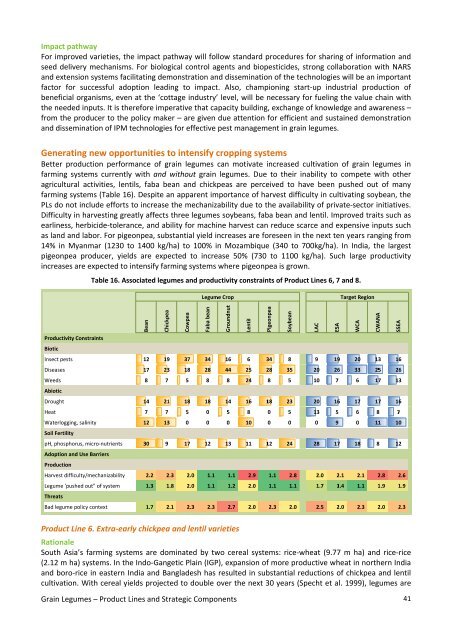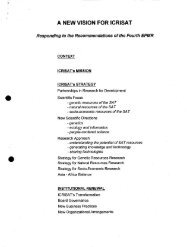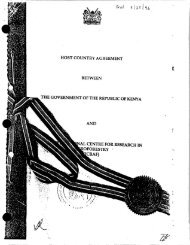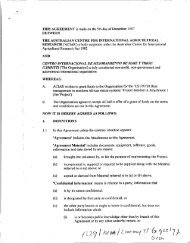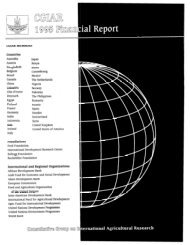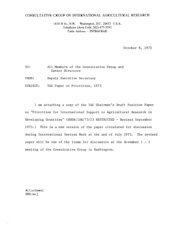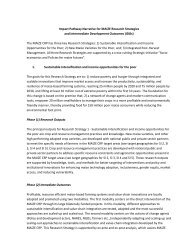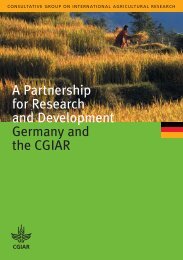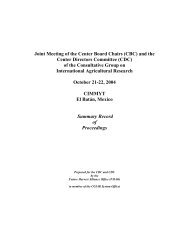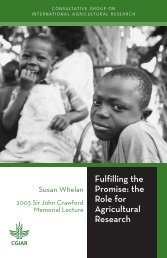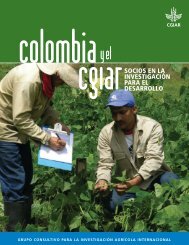CGIAR Research Program on Grain Legumes: Proposal - Library
CGIAR Research Program on Grain Legumes: Proposal - Library
CGIAR Research Program on Grain Legumes: Proposal - Library
- No tags were found...
You also want an ePaper? Increase the reach of your titles
YUMPU automatically turns print PDFs into web optimized ePapers that Google loves.
Impact pathwayFor improved varieties, the impact pathway will follow standard procedures for sharing of informati<strong>on</strong> andseed delivery mechanisms. For biological c<strong>on</strong>trol agents and biopesticides, str<strong>on</strong>g collaborati<strong>on</strong> with NARSand extensi<strong>on</strong> systems facilitating dem<strong>on</strong>strati<strong>on</strong> and disseminati<strong>on</strong> of the technologies will be an importantfactor for successful adopti<strong>on</strong> leading to impact. Also, champi<strong>on</strong>ing start-up industrial producti<strong>on</strong> ofbeneficial organisms, even at the ‘cottage industry’ level, will be necessary for fueling the value chain withthe needed inputs. It is therefore imperative that capacity building, exchange of knowledge and awareness –from the producer to the policy maker – are given due attenti<strong>on</strong> for efficient and sustained dem<strong>on</strong>strati<strong>on</strong>and disseminati<strong>on</strong> of IPM technologies for effective pest management in grain legumes.Generating new opportunities to intensify cropping systemsBetter producti<strong>on</strong> performance of grain legumes can motivate increased cultivati<strong>on</strong> of grain legumes infarming systems currently with and without grain legumes. Due to their inability to compete with otheragricultural activities, lentils, faba bean and chickpeas are perceived to have been pushed out of manyfarming systems (Table 16). Despite an apparent importance of harvest difficulty in cultivating soybean, thePLs do not include efforts to increase the mechanizability due to the availability of private-sector initiatives.Difficulty in harvesting greatly affects three legumes soybeans, faba bean and lentil. Improved traits such asearliness, herbicide-tolerance, and ability for machine harvest can reduce scarce and expensive inputs suchas land and labor. For pige<strong>on</strong>pea, substantial yield increases are foreseen in the next ten years ranging from14% in Myanmar (1230 to 1400 kg/ha) to 100% in Mozambique (340 to 700kg/ha). In India, the largestpige<strong>on</strong>pea producer, yields are expected to increase 50% (730 to 1100 kg/ha). Such large productivityincreases are expected to intensify farming systems where pige<strong>on</strong>pea is grown.Table 16. Associated legumes and productivity c<strong>on</strong>straints of Product Lines 6, 7 and 8.Product Line 6. Extra-early chickpea and lentil varietiesRati<strong>on</strong>aleSouth Asia’s farming systems are dominated by two cereal systems: rice-wheat (9.77 m ha) and rice-rice(2.12 m ha) systems. In the Indo-Gangetic Plain (IGP), expansi<strong>on</strong> of more productive wheat in northern Indiaand boro-rice in eastern India and Bangladesh has resulted in substantial reducti<strong>on</strong>s of chickpea and lentilcultivati<strong>on</strong>. With cereal yields projected to double over the next 30 years (Specht et al. 1999), legumes are<strong>Grain</strong> <strong>Legumes</strong> – Product Lines and Strategic Comp<strong>on</strong>ents 41


